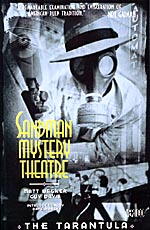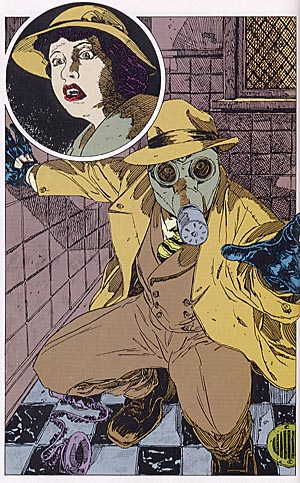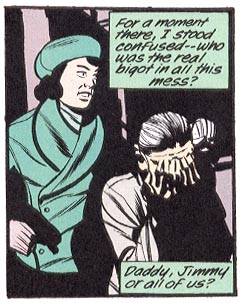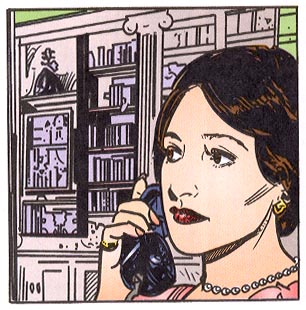 Written by Matt Wagner
Written by Matt Wagner
Art by Guy Davis, John Watkiss, and R.G. Taylor
112 pages & 208 pages, color
Published by Vertigo/DC Comics
I have a confession to make: when it was first published, I stopped buying Sandman Mystery Theatre after six issues. In 1993 I didn’t have much money to spend on comics, and comics quickly got dropped off of my list of things to buy if they lost my attention. Now that DC Comics has released the first 12 issues of the series in two collected volumes, though, I figured it was time to see if, a decade later, my tastes had matured a bit more and it would be more to my liking… or if perhaps I was right the first time I decided that the book was not for me.
The original model for the series was that Matt Wagner would write Sandman Mystery Theatre as a series of four-issue story arcs; Guy Davis and John Watkiss would each draw one story arc a year, and the third slot would be a series of rotating artists. It was a formula that would change after the very first year; while the four-issue stories remained, Steven T. Seagle would join the book as a co-writer starting with issue #13, while Guy Davis also became the sole regular artist on the book at the same time. It’s interesting, then, to look back at this first year’s stories about Wesley Dodds and his exploits in the 1930s as he fought crime as the mysterious Sandman and view these collected twelve issues almost as a year long experiment.
 Sandman Mystery Theatre Vol. 1: The Tarantula is far and away the strongest of the series’s initial three stories. Wagner and Davis introduce the duo of Wesley Dodds and Dian Belmont by letting them meet each other for the first time in the pages of the comic, letting us see each of them through the other’s eyes. The primary focus of The Tarantula is in many ways more on Dian Belmont, something that helps set Sandman Mystery Theatre apart from a lot of other books by making sure that the hero’s “other half” is more than just a sidekick or a potential love interest, but a fully fledged character in their own right. Dian’s strong will and determination quickly grabs control of the series, and in many ways she is presented to us as the protagonist of the series with whom we can relate to. It’s her friend that goes missing in the clutches of the Tarantula, and it’s she that tries to piece together where Catherine has gone by using all assets available to her. Wesley Dodds, by way of contrast, is almost more of a force of nature in The Tarantula, his motives and thought processes a mystery not only to the police and District Attorney Lawrence Belmont, but to an extent the reader as well. It’s a storytelling technique that works as an introduction to Sandman Mystery Theatre, but admittedly one that might be difficult to maintain in the long run. Davis’s art is a perfect fit for Wagner’s story; its delicate lines give an almost old-fashioned look to the series, but without sacrificing any dramatic potential needed. Davis is able to manipulate his panels to plunge the scene into shadow to provide the appropriate level of mood, or bring crystal clarity to a scene to let the reader get a glimpse of every last detail and it looks just as good no matter what the technique used. It’s easy to see why when the series went down to just a single regular artist, Davis was the creator turned to.
Sandman Mystery Theatre Vol. 1: The Tarantula is far and away the strongest of the series’s initial three stories. Wagner and Davis introduce the duo of Wesley Dodds and Dian Belmont by letting them meet each other for the first time in the pages of the comic, letting us see each of them through the other’s eyes. The primary focus of The Tarantula is in many ways more on Dian Belmont, something that helps set Sandman Mystery Theatre apart from a lot of other books by making sure that the hero’s “other half” is more than just a sidekick or a potential love interest, but a fully fledged character in their own right. Dian’s strong will and determination quickly grabs control of the series, and in many ways she is presented to us as the protagonist of the series with whom we can relate to. It’s her friend that goes missing in the clutches of the Tarantula, and it’s she that tries to piece together where Catherine has gone by using all assets available to her. Wesley Dodds, by way of contrast, is almost more of a force of nature in The Tarantula, his motives and thought processes a mystery not only to the police and District Attorney Lawrence Belmont, but to an extent the reader as well. It’s a storytelling technique that works as an introduction to Sandman Mystery Theatre, but admittedly one that might be difficult to maintain in the long run. Davis’s art is a perfect fit for Wagner’s story; its delicate lines give an almost old-fashioned look to the series, but without sacrificing any dramatic potential needed. Davis is able to manipulate his panels to plunge the scene into shadow to provide the appropriate level of mood, or bring crystal clarity to a scene to let the reader get a glimpse of every last detail and it looks just as good no matter what the technique used. It’s easy to see why when the series went down to just a single regular artist, Davis was the creator turned to.
 The first half of Sandman Mystery Theatre Vol. 2: The Face and The Brute is drawn by John Watkiss, and the story of The Face is originally what led me to abandon the book. Reading through it just over a decade later, it was almost disappointing to see that The Face hadn’t aged well. Where The Tarantula was a mystery that lets the reader try and puzzle out the pieces even as the characters do the same thing, The Face‘s revelations come out of nowhere, making the mystery aspect of the book unsatisfying as a reader. Wesley Dodds slowly begins to make more of a presence as one of the stars of the book, with Wagner letting us into his head a fraction more than before, and it’s really the high point of The Face and the main reason to read the story. Less enticing is Watkiss’s art, which starts off acceptable with its angular and drawn out faces but gets sloppier with each new chapter. David Hornung’s colors, with its eye-popping pastels, doesn’t mesh well with Watkiss’s art and the result is what’s almost a visual smear across the page by the time the story comes to a conclusion. Perhaps worst of all, Watkiss draws a story starring a handful of Asian characters and makes most of them indistinguishable from each other. It’s a horrible stereotype come to life, and more than a little mortifying to read. In the end I had to come to the conclusion that in even 1993, I had developed enough taste to have disliked The Face, and in many ways it’s a bit of a failure.
The first half of Sandman Mystery Theatre Vol. 2: The Face and The Brute is drawn by John Watkiss, and the story of The Face is originally what led me to abandon the book. Reading through it just over a decade later, it was almost disappointing to see that The Face hadn’t aged well. Where The Tarantula was a mystery that lets the reader try and puzzle out the pieces even as the characters do the same thing, The Face‘s revelations come out of nowhere, making the mystery aspect of the book unsatisfying as a reader. Wesley Dodds slowly begins to make more of a presence as one of the stars of the book, with Wagner letting us into his head a fraction more than before, and it’s really the high point of The Face and the main reason to read the story. Less enticing is Watkiss’s art, which starts off acceptable with its angular and drawn out faces but gets sloppier with each new chapter. David Hornung’s colors, with its eye-popping pastels, doesn’t mesh well with Watkiss’s art and the result is what’s almost a visual smear across the page by the time the story comes to a conclusion. Perhaps worst of all, Watkiss draws a story starring a handful of Asian characters and makes most of them indistinguishable from each other. It’s a horrible stereotype come to life, and more than a little mortifying to read. In the end I had to come to the conclusion that in even 1993, I had developed enough taste to have disliked The Face, and in many ways it’s a bit of a failure.
 After reading The Face I was hesitant to read The Brute, the second half of Sandman Mystery Theatre Vol. 2: The Face and The Brute and the one story from the series’s first year that I knew almost nothing about. I was surprised, then, to discover a shift not only in the art of Sandman Mystery Theatre, but also the writing. Wagner takes a slightly different tactic for The Brute, telling a suspense noir story instead of a strict mystery. The identity of the wrong-doers is easily on display, with the real question not being “who did it?” but “what will happen next?” Wagner’s characters of the Ramsey family are the focal point of the bad things that happen in The Brute, and it’s hard to not feel pity for the father and daughter caught up in other people’s schemes and evil. At the same time, Wagner also continues to push Wesley into the limelight even as his and Dian’s relationship grows. It’s a clever technique, letting Wesley’s prominence in his own book grow in a direct corollary to his connection to Dian, in many ways a reversal to how most books helmed by a male hero function with regard to the female cast. Taylor’s art is an interesting choice for the book, looking almost like a series of portrait sketches come to life, with their loose lines framing the faces, a real focus given to the form of the human body and how it moves. It’s a decidedly non-commercial look for comics, but there’s a real grace to it that might elude people who just give the book a casual glance. It’s a shame that The Brute was Taylor’s only appearance in the pages of Sandman Mystery Theatre, because after this one helping I was ready for more.
After reading The Face I was hesitant to read The Brute, the second half of Sandman Mystery Theatre Vol. 2: The Face and The Brute and the one story from the series’s first year that I knew almost nothing about. I was surprised, then, to discover a shift not only in the art of Sandman Mystery Theatre, but also the writing. Wagner takes a slightly different tactic for The Brute, telling a suspense noir story instead of a strict mystery. The identity of the wrong-doers is easily on display, with the real question not being “who did it?” but “what will happen next?” Wagner’s characters of the Ramsey family are the focal point of the bad things that happen in The Brute, and it’s hard to not feel pity for the father and daughter caught up in other people’s schemes and evil. At the same time, Wagner also continues to push Wesley into the limelight even as his and Dian’s relationship grows. It’s a clever technique, letting Wesley’s prominence in his own book grow in a direct corollary to his connection to Dian, in many ways a reversal to how most books helmed by a male hero function with regard to the female cast. Taylor’s art is an interesting choice for the book, looking almost like a series of portrait sketches come to life, with their loose lines framing the faces, a real focus given to the form of the human body and how it moves. It’s a decidedly non-commercial look for comics, but there’s a real grace to it that might elude people who just give the book a casual glance. It’s a shame that The Brute was Taylor’s only appearance in the pages of Sandman Mystery Theatre, because after this one helping I was ready for more.
Reading through the first year of Sandman Mystery Theatre in one sitting, it was a real pleasure to see how Wagner structured its twelve issues to slowly build over the course of the year, both in terms of introducing Wesley to the readers as well as to Dian. I’m glad that Vertigo gave us as readers another chance to give Sandman Mystery Theatre a try; in a marketplace that seems slightly more accepting of mysteries and crime noir stories, hopefully it’ll finally get the higher sales that the series clearly deserved. The one stumble from the first year (The Face) is wisely packaged with a successful story, and in the end I’m really happy that I bought both volumes. Best of all, while these two volumes collect just the first 12 issues of the series, the book ran for 70 issues (plus one Annual), which means that we could still have seven or eight more collected volumes if sales demand it. I don’t know about sales, but as a reader I’m demanding it. Let’s hope there are enough other like-minded readers out there who agree what it took me only eleven years to finally figure out: Sandman Mystery Theatre is a great book.
Purchase Links (Vol. 1):
